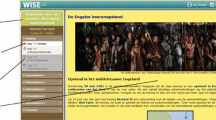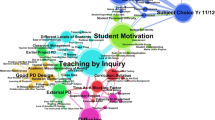Abstract
Inquiry Into Life Science is a content biology course expressly for the fulfillment of the General Education life science laboratory course requirement of elementary education majors at this university. The course is modeled on the Teaching Standards and Content Standards of the National Science Education Standards [National Research Council. (1996). The national science education standards. Washington. DC: National Academy Press]. The change in intentions of 61 Fall 2002 enrollees were studied using triangulated quantitative and qualitative techniques to seek specific changes regarding self-perceived effectiveness as a biology teacher, self-perceived subject matter command, curriculum development competence, and pedagogical skills, all linked to developing intentions. Significant growth in all four domains was observed. These findings contribute to the research-based call for inquiry-oriented college science coursework for preservice teachers.
Similar content being viewed by others
References
Abell, S., & Roth, M. (1992). Constraints to teaching elementary science: A case study of a science enthusiast student teacher. Science Education, 76, 581–595.
Anderson, R., & Mitchener, C. (1993). Research on science teacher education. In D.~L. Gabel (Ed.), Handbook of research on science teaching and learning (pp. 3–44). New York: Macmillan.
Appleton, K. (1997). Teaching elementary science: Exploring the issues. Rockhampton, Australia: Central Queensland University Press.
Appleton, K., & Kindt, I. (2002). Beginning elementary teachers’ development as teachers of science. Journal of Science Teacher Education, 13, 43–61.
AstraZeneca Science Teaching Trust. (2002). Attitudes to Science Teaching Questionnaire. Leicester City, UK: Leicester City Primary Science Project.
Barnes, M., & Spector, B. (1999, January). Creating contexts for inquiry in science teacher preparation: How do we do it? Paper presented at the annual meeting of the Association for the Education of Teachers of Science, Austin, TX.
Barufaldi, J., Huntsberger, J., & Lazarowitz, R. (1976). Changes in attitude of preservice elementary education majors toward inquiry teaching strategies. School Science and Mathematics, 76, 420–424.
Bohning, G., & Hale, L. (1998). Images of self-confidence and the change-of-career prospective elementary science teacher. Journal of Elementary Science Education, 10(1), 39–59.
Bonnstetter, R., & Yager, R. (1985). What research says: A profile of excellence: Teachers of exemplary programs in elementary science. Science and Children, 22, 45–46.
Bransford, J., Brown, A., & Cocking, R. (2000). How people learn. Washington, DC: National Academy Press.
Brown, C., & Borko, H. (1992). Becoming a mathematics teacher. In D. A. Grouws (Ed.), Handbook of research on mathematics teaching & learning (pp. 209–242). New York: Macmillan.
Butts, D., Koballa, T., & Elliott, T. (1997). Does participating in an undergraduate elementary science methods course make a difference? Journal of Elementary Science Education, 9(2), 1–17.
Bybee, R. (1997). Achieving scientific literacy: From purposes to practices. Portsmouth, NH: Heinemann.
Chiappetta, E., Koballa, T., & Collette, A. (1998). Science instruction in the middle and high schools. Upper Saddle River, NJ: Prentice Hall.
Clough, M. (2002). Using the laboratory to enhance student learning. In R. W. Bybee (Ed.), Learning science and the science of learning (pp. 85–94). Arlington, VA: NSTA Press.
Cox, C., & Carpenter, J. (1989). Improving attitudes toward teaching science and reducing science anxiety through increasing confidence in science ability in inservice elementary school teachers. Journal of Elementary Science Education, 1(2), 14–35.
Crawford, B. (1999). Is it realistic to expect a preservice teacher to create an inquiry-based classroom? Journal of Science Teacher Education, 10, 175–194.
Creswell, J. (1994). Research design: Qualitative and quantitative approaches. Thousand Oaks, CA: Sage.
Downing, J., & Filer, J. (1999). Science process skills and attitudes of preservice elementary teachers. Journal of Elementary Science Education, 11(2), 57–64.
Eiriksson, S. (1997). Preservice teachers’ perceived constraints of teaching science in the elementary classroom. Journal of Elementary Science Education, 9(2), 18–27.
Fones, S., Wagner, J., & Caldwell, E. (1999). Promoting attitude adjustments in science for preservice elementary teachers. Journal of College Science Teaching, 28, 231–236.
Friedman, D. (1999). Science, YES!—A program to excite the scientist in the teacher. Journal of College Science Teaching, 28, 239–244.
Fulp, S. L. (2002). The status of elementary school science teaching. Available online: http://www.horizon-research.com/reports/2002/2000survey/elem_sci.php.
Gibson, H., Bernhard, J., Kropf, A., & Van Strat, G. (2001, January). The impact of constructivist instructional methods on preservice teachers’ attitudes toward teaching and learning science. Paper presented at the annual meeting of the Association for the Education of Teachers of Science, Costa Mesa, CA.
Huinker, D., & Madison, S. (1997). Preparing efficacious elementary teachers in science and mathematics: The influence of methods courses. Journal of Science Teacher Education, 8, 107–126.
Loucks-Horsley, S. (1998). The role of teaching and learning in systemic reform: A focus on professional development. Science Educator, 7, 1–6.
Lucas, K., & Dooley, J. (1982). Student teachers’ attitudes toward science and science teaching. Journal of Research in Science Teaching, 19, 805–809.
Lumpe, A., Czerniak, C., & Haney, J. (1999). Supporting the implementation of inquiry-based elementary science programs: Setting the stage for local reform. Electronic Journal of Science Education, 3(4). Available online: http://www.unr.edu/homepage/crowther/ejse/ejsev3n4.html.
Lunetta, V. (1975). Field-based clinical experiences in science teacher education. Science Education, 59, 517–520.
Minium, E., King, B., & Bear, G. (1993). Statistical reasoning in psychology and education. New York: John Wiley & Sons.
National Research Council. (1999). Transforming undergraduate education in science, mathematics, engineering, and technology. Washington, DC: National Academy Press.
National Research Council. (1996). The national science education standards. Washington. DC: National Academy Press.
National Research Council. (2001). Educating teachers of science, mathematics, and technology. Washington, DC: National Academy Press.
National Science Resource Center. (1997). Science for all children. Washington DC: National Academy Press.
Patton, M. (1990). Qualitative evaluation and research methods. Newbury Park, CA: Sage.
Penick, J. (2000). Coaches’ manual for science education. The Clearinghouse Special Edition on Secondary Science Education, 74(1), 47–50.
Prestt, B. (1982). Initial training of science teachers. In A. Jennings & R. Ingle (Eds.), Science teachers for tomorrow’s schools (pp. 47–51). London: Bedford Way Papers, University of London.
Raizen, S., & Michelsohn, A. (1993). The future of science in elementary schools: Educating prospective teachers. San Francisco: Jossey-Bass.
Reisert, P., & Kielbasa, M. (1999). Improving science education for future teachers. Journal of College Science Teaching, 28, 278–283.
Ross, D., & Mason, C. (2001, January). University science majors in collaborative partnerships with elementary teachers: Inquiry based teaching and learning. Paper presented at the annual meeting of the Association for the Education of Teachers of Science, Costa Mesa, CA.
Rutherford, F., & Ahlgren, A. (1990). Science for all Americans. New York: Oxford University Press.
Silverstein, S. (1999). Preprogram survey of the Scientific Work Experience Program for Teachers (SWEPT). New York: Columbia University.
Sivertsen, M. (1993). Transforming ideas for teaching and learning science: A guide for elementary science education. Washington, DC: US Department of Education, Office of Educational Research and Improvement.
Spector, B., & Strong, P. (2001). The culture of traditional preservice elementary science methods students compared to the culture of science: A dilemma for teacher educators. Journal of Elementary Science Education, 13(1), 1–20.
Stefanich, G., & Kelsey, K. (1989). Improving science attitudes of preservice elementary teachers. Science Education, 73, 187–194.
Stevens, C., & Wenner, G. (1996). Elementary preservice teachers’ knowledge and beliefs regarding science and mathematics. School Science and Mathematics, 96(1), 2–9.
Stuart, C., & Thurlow, D. (2000). Making it their own: Preservice teachers’ experiences, beliefs, and classroom practices. Journal of Teacher Education, 51, 113–121.
Sumrall, W. J. (1997). Why avoid hands-on science? Science Scope, 20, 16–19
Sunal, D. (1980). Effect of field experience during elementary methods courses on preservice teacher behavior. Journal of Research in Science Teaching, 17, 17–23.
Tobin, K., Tippins, D., & Gallard, A. (1994). Research on instructional strategies for teaching science. In D. L. Gabel (Ed.), Handbook of research on science teaching and learning (pp. 45–93). New York: Macmillan.
Varley, P. (1975). Science in the primary school. Brisbane, Australia: Department of Education, Queensland, Research Branch.
Watters, J., & Ginns, I. (2000). Developing motivation to teach elementary science: Effect of collaborative and authentic learning practices in preservice education. Journal of Science Teacher Education, 11, 301–321.
Wenner, G. (1993). Relationship between science knowledge levels and beliefs toward science instruction held by preservice elementary teachers. Journal of Science Education and Technology, 2, 461–468.
Yager, R., & Penick, J. (1990). Science teacher education. In W. R. Houston (Ed.), Handbook of research on teacher education (pp. 657–673). New York: Macmillan.
Author information
Authors and Affiliations
About this article
Cite this article
Weld, J., Funk, L. “I’m Not the Science Type”: Effect of an Inquiry Biology Content Course on Preservice Elementary Teachers’ Intentions About Teaching Science. J Sci Teacher Educ 16, 189–204 (2005). https://doi.org/10.1007/s10972-005-4860-2
Issue Date:
DOI: https://doi.org/10.1007/s10972-005-4860-2




